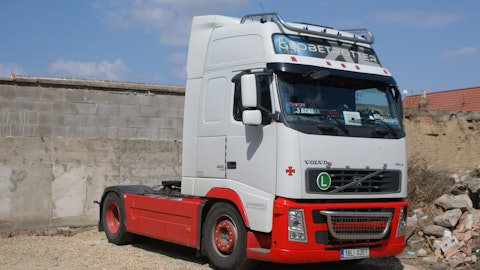Rush Enterprises, Inc. (NASDAQ:RUSHA) Q3 2023 Earnings Call Transcript October 25, 2023
Operator: Good day, and thank you for standing by. Welcome to the Rush Enterprises, Incorporated. Third Quarter 2023 Earnings Results Conference Call. [Operator Instructions] Please be advised that today’s conference is being recorded. I would now like to hand the conference over to your speaker today, Rusty Rush, Chairman, President and Chief Executive Officer. Please go ahead, sir.
Rusty Rush: Good morning, and welcome to our third quarter 2023 earnings release conference call. On the call are Mike McRoberts, Chief Operating Officer; Steve Keller, Chief Financial Officer; Jay Hazelwood, Vice President and Controller; and Michael Goldstone, Senior Vice President, General Counsel and Corporate Secretary. Now Steve will say a few words regarding forward-looking statements.
Steve Keller: Certain statements we will make today are considered forward-looking statements as defined in the Private Securities Litigation Reform Act of 1995. Because these statements include risks and uncertainties, our actual results may differ materially from those expressed or implied by such forward-looking statements. Important factors that could cause actual results to differ materially from those expressed or implied by such forward-looking statements include, but are not limited to, those discussed in our annual report on Form 10-K for the year ended December 31, 2022 and in our other filings with the Securities and Exchange Commission.
Rusty Rush: As indicated in our news release, we achieved third quarter revenues of $2 billion and net income of $80.3 million or $0.96 per diluted share. We are proud to declare a cash dividend of $0.17 per common share. In the third quarter, we achieved strong financial results due to revenue growth from our expanded service technician workforce, our support of large national accounts and ongoing pent-up demand for new Class 8 and Class 4-7 trucks, following a limited new truck production in the past few years. Though our largest customer segment, the over-the-road customers, are being negatively affected by high interest rates, low freight rates and other economic factors, ongoing focus on our strategic initiatives helped us partially offset these challenges and achieved strong financial results in the third quarter.

In the aftermarket, our parts, service and body shop revenues were $643.6 million, up 3.5% for our absorption rate was 132.8. Through our aftermarket revenue has slowed – growth has slowed compared to previous quarters. The diversity of our customer base, our technician workforce and focus on large national accounts fueled our strong aftermarket results this quarter. Looking ahead, we believe aftermarket growth will continue to moderate through the rest of this year, and we are closely monitoring consumer spending and other economic conditions, which could impact parts and service demand. In the fourth quarter, we believe customer demand for aftermarket services will remain steady and that our aftermarket results will be similar to the third quarter, with slight adjustments caused by normal seasonal softness and fewer working days in the quarter.
Turning to truck sales. We sold 4,326 new Class 8 trucks in the quarter, guiding for 6.1% of the US market and 2.1% in the Canadian market. Low freight rates continue to affect smaller operators, but strong pent-up demand continues due to limited to truck production over the past few years. While there’s still new truck supply issues causing us to still be on allocation from our OEMs, new truck production continued to improve in the third quarter, resulting in significantly shorter lead times for new tucks. ACT Research forecast US truck sales, Class A truck sales to be 278,000 in 2023, up 7.2% compared to 20.2%. We believe pent-up demand for Class 8 trucks will last through the fourth quarter and then our fourth quarter Class 8 truck performance will align with our third quarter results.
Our Class 4-7 new truck sales reached 3,244 units in the third quarter, accounting for 4.8% of the US market and 2.3% of the Canadian market. We experienced solid demand from a variety of market segments. And those truck manufacturers are loading more resources to medium-duty trucks. Production remains limited and unmet demand in the market remains. ACT Research forecast Class – US Class 4-7 for retail sales to be 253,000 units in 2023, up 8.5% from 2022. We are closely watching consumer spending and other economic factors, which could impact our new Class 4-7 units, but continued pent-up demand with significantly signed, we expect our fourth quarter results will align with our third quarter results. Our used truck sales reached 1,797 units in the third quarter, up 1.9% year-over-year.
New truck production, soft freight rates, tight credit conditions led to continued weak demand in our industry in the third quarter, used truck values to continue to decline at an accelerated rate, though the rate of decline is slow and values appear to be normalizing. With new truck production continuing to increase with freight rates not expected to improve significantly in the fourth quarter. We expect used truck demand will remain low to the end of this year. We plan to maintain our inventory at lower than normal levels and believe we are well positioned to navigate these challenging market conditions. We expect that our fourth quarter used truck results will be consistent again with our third quarter. As we look ahead, we believe pent-up demand for Class 8 trucks will substantially be satisfied by the end of the fourth quarter, and that new truck production has continued to improve.
We will continue to monitor economic factors, which are impacting our customers, especially over-the-road carriers. While we expect typical seasonal softness in the fourth quarter, we believe our financial results will align with the third quarter results and we will close the year strong. As always, it is important for me to thank our employees for their great work every day and for staying focused on our company’s long-term strategic initiatives, while providing superior service to our customers. With that, I’ll take your questions.
See also 17 Biggest Mistakes New Business Owners Make and 24 States Where Sports Betting Is Legal .
Q&A Session
Follow Rush Enterprises Inc (NASDAQ:RUSHA)
Follow Rush Enterprises Inc (NASDAQ:RUSHA)
Operator: Thank you. [Operator Instructions] Our first question comes from the line of Andrew Obin with Bank of America. Your line is now open.
Andrew Obin: Hey Rusty, how are you? Rusty and Steve team, how are you?
Rusty Rush: Very good. Thank you, Andrew.
Andrew Obin: So first question is, I think Traton was saying today that they think they’re starting to start sales of the new S13 engine and expect to ship on quarter Navistar units in ’24. So does this have any impact on your sort of profitability in the Navistar franchise going forward? And can you also remind us how you’re positioned on the Cummins engines outside of your vertically integrated model on PACCAR? Thank you.
Rusty Rush: You bet. Well, the S13, we’re excited about it. We know that Volkswagen is excited about it and Navistar is excited about it. We’re going to start a little slower than what we anticipated with the engine getting it here. We were hoping to get a few more this year than what we’ve gotten. But we’re excited, and we’ll be showing up in 2024. That said, when it comes to profitability. Remember, typically, the most important thing that you derive, we’re excited with what we believe will be a great performance of it. It’s the long-term parts profitability that goes with it because it makes — parts become more [indiscernible] to that brand. So we would expect that over time to definitely have an effect in the profitability of the overall of the Navistar franchises. I’m thinking about trying to understand your Cummins question. Obviously…
Andrew Obin: Just what’s happening with Cummins and what’s your position? What’s your relationship with Cummins comments, just remind us.
Rusty Rush: Sure. Well, our Cummins relationship is great. From an engine perspective, we’re the largest distributor of Cummins engines, considering their two largest customers PACCAR and Navistar, were the largest dealer — we’re the largest Navistar dealer, right? So we’re probably the largest retail dealer in the world, I would guess, when it comes to retail delivery. We also have a very strong relationship across the board. It’s much deeper than just that. Remember, we’ve got our JV, our joint venture, which is — we call it CCFT, Cummins Clean Fuel Technologies as with them on the natural gas fuel system side, because we both believe they bought 50% share in that here January 1 of 2022 and we have accelerated our investments is what we prepare for what we believe a big opportunity for that market share to increase from what it’s always stayed around 2%.
We think over the next two to three years that that share can increase 7% 8% 9% as the — especially the truckload side the over-the-road long haul side has to wrestle with all the pressures — the environmental pressures that we’re dealing with. Right now fuel cell is still ways away. Hydrogens are ways away. And I don’t believe electric is a ways away when it comes to meeting the needs of a 400 or 500-mile haul on a daily basis. None of those are set up for that right now. So we believe they’re bringing over their new 15-liter engine. And we do believe that the other that partnership is going to be doing really well for us really as we get into 2025, 2026 starting to accelerate 2024 but in 2025, 2026 and getting to 2027, we believe we’ve got a lot of opportunity around that from a fuel system side.
So as I said it’s a very broad relationship with them. And we’re excited to have that relationship and forward to continue to working with them like we have always.
Andrew Obin: Thank you. And just a follow-up question on, your saying that Q4 is roughly going to be in line with Q3. And I hate to be asked a question about next year. But how sustainable is the quarterly pace? We know that you’re sort of telegraphing that new unit sales are going to be down, but you have your own dynamic and then the aftermarket. How sustainable is the earnings power, I don’t know let’s call it around $0.90 going forward? Thank you.


